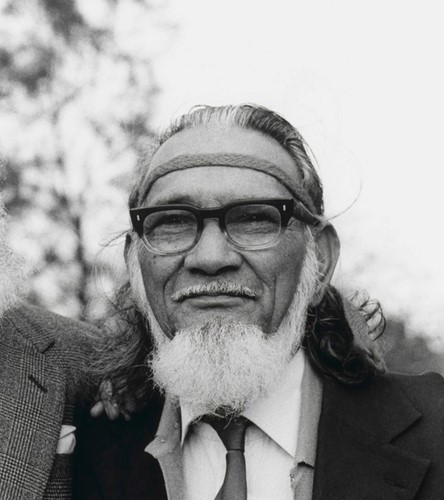South Coast NSW History Story
Guboo (Ted) Thomas
Guboo (Ted) Thomas
Gubboo (Ted) Thomas will always be associated with Biamanga (Mumbulla Mountain). He would walk to the summit and spend days there in contemplation but, perhaps more importantly, he led the campaign to stop logging on Mumbulla Mountain and to have it recognized and protected as an Aboriginal Place.
Edwin Thomas was born in January 1909 at Jembaicumbene near Braidwood. His birth name was Edwin, which was contracted to Ted, although he became better known by his tribal name Guboo which means ‘good friend’. His father and grandfather were both Yuin elders and his mother was part-Aboriginal, part Chinese, with French ancestry. He was the third of 10 children. He was recognised as a future spiritual leader by the elders of the Yuin before he turned 10 years old.
Guboo grew up on the Wallaga Lake Aboriginal Reserve where he attended the tiny local school until he was eight years old. He recalled this time: ‘All I was taught at school was to knit, sew, make little johnnycakes and tend a garden. In those days, no-one bothered to teach the Aboriginal children the three Rs.’ He was withdrawn from school by his parents and his education in his "Dreamtime culture" then began. When he was nine, his father, uncle and other Yuin elders took him on a Dreamtime walkabout from Malacoota to the Hawkesbury River, showing him all the Aboriginal sacred sites along the way. They also instructed him in sacred Aboriginal rites, male ancestral law and Yuin customs. His grandmother, a ‘medicine woman’, took him on her healing rounds and taught him the Yuin Dreamtime stories. These groundings prepared him to become the future elder and spiritual leader of the Yuin ‘Nation’ which he always maintained was made up of many individual tribes.
As a teenager and a young man he was a member (as was his father, his uncles and three of his brothers) of the Wallaga Lake Gumleaf Band that toured southern NSW and Victoria, and performed at the opening of the Sydney Harbour Bridge in 1932. During visits to Aboriginal missions he would talk to the old people to learn more about their customs and beliefs, tour their sacred sites and talk about protecting the land and the Great Spirit that sustained it.
After his music career, Guboo worked as a jackaroo, shellac collector, railway sleeper cutter and was a member of an Aboriginal work-crew that felled timber ahead of the rising waters when Warragamba Dam was constructed. However, for most of his working life, he was a commercial fisherman on the South Coast.
In 1967, following the Australian referendum that gave citizenship to Aboriginals, Guboo and his family moved back to Wallaga Lake to concentrate on his responsibilities as a tribal elder. He also became committed to promoting Aboriginal land rights and preserving Aboriginal culture, his catch-cry being "Land rights, self-determination, and cultural identity." He hitchhiked to Canberra to pressure the Government to make the Wallaga Lake Aboriginal Mission into a reserve and to seek protection of the sacred sites. Work he undertook with the Institute of Aboriginal Studies, recording all the Aboriginal sites in coastal New South Wales, became the basis of all future land claims along the South Coast. In 1978 he helped prepared land claims that were presented to the New South Wales Government and which ultimately resulted in the Wallaga Lake community receiving its title deeds.
Around the same time, Guboo became alarmed about forestry operations on nearby Mumbulla Mountain threatening sacred sites. The NSW National Parks and Wildlife Service, with the help of Guboo Thomas, commenced an anthropological and archaeological investigation of Mumbulla Mountain which supported the claims of the Yuin people that Mumbulla Mountain was significant to Aboriginal people. In 1979, largely as a result of Guboo’s efforts, NSW Premier Neville Wran ordered a cessation to logging on Mumbulla Mountain south of Bermagui.
Guboo (Ted) Thomas died in May 2002, several years before ownership of the former Wallaga Lake Aboriginal Mission and the rest of Gulaga National Park was transferred back to the area's original owners, the Yuin people, in May 2006.
Guboo was deeply spiritual. He wanted to restore people’s unity with the land, to bring people together through a mutual love and respect for Mother Earth, and he wanted to encourage a return to selfless ancient values. For 20 years he held ‘Dreaming Camps’ throughout Australia and overseas, aimed at passing on his knowledge, renewing the Dreaming of different places, and restoring sacredness to the landscape.
He became a member of the Baha’i faith which emphasizes the spiritual unity of humankind through all religions. He also visited the United Nations, and asked the World Council of Churches to accept Indigenous religions.
Guboo strove to make Australia a nation that has put conflict between white and black Australians behind it - a unified nation having respect for Aboriginal culture and a love of the land. However, it was a message that, ironically, fell flat among his own people and increasingly he became mistrusted by other Aboriginals (who portrayed him as having discovered the perks of ‘new-age guru’ to the white community).
‘The Earth is our Mother.
When I die I'm going down there.
When you die you're going there too.
But what are you doing for the Earth?’
- Guboo (Ted) Thomas
Sources: Australian Aboriginal Studies, Vol 2002 No 2, Wikipedia, Bega District News and ABC South East (both via google searches).
